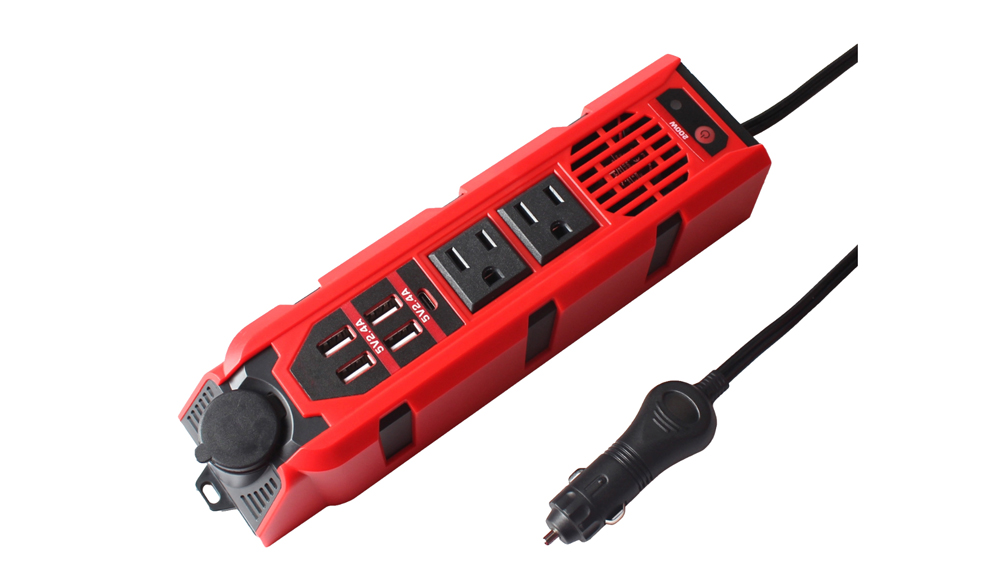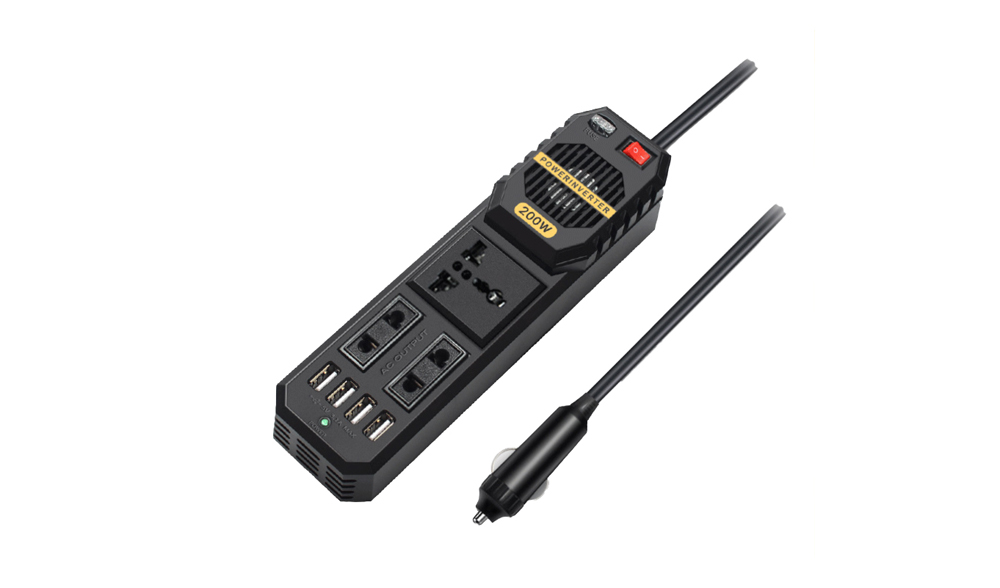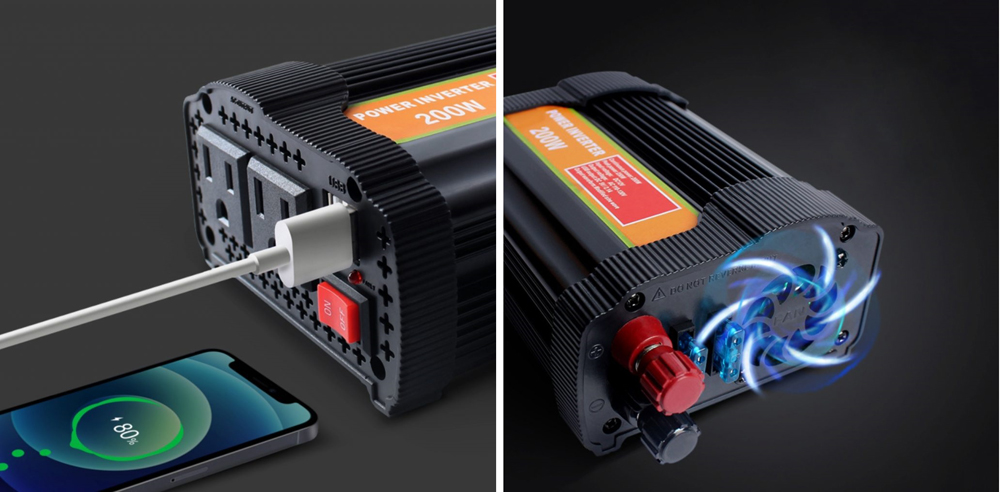A power inverter can convert low-voltage DC current from batteries into standard household AC power supply. With the help of power inverters, we can use a variety of lead acid and lithium batteries in cars and boats to power common household electrical, electronic and other appliances. There are many kinds of power inverters, among which the most commonly used in our life are car power inverters. To a certain extent, car power inverters can be used as portable power sources in the absence of a standard power supply. Next, let’s take a look at what a car power inverter is for, how it works, and how to choose a car power inverter.
Purpose of a Power Inverter
Simply speaking, a power inverter is a device that can provide AC power supply when you can’t use your home power sockets. The demands for power inverters are often found in cars, boats, construction sites, campsites and many other locations where there is difficulty maintaining a stable and standard power supply. They can also be used as an emergency source of power for a certain period of time in the event of a power failure. They can replace generators during outages or reduce the frequency of generator use.

How a Car Power Inverter Works
When at work, a power inverter needs to be connected to the cigarette lighter of the car. During operation, the direct current from a car battery, usually at 12V or 24V, flows out of the battery’s negative terminal in one direction. The current then flows through the circuit and back to the positive terminal of the battery. A car power inverter works by increasing the voltage and using a transistor or semiconductor to quickly swap the positive and negative terminals of the direct current back and forth and send it one way through the circuit. After that, the inverter will swap it again and send it another way. Typically, this conversion is performed 60 times per second by a car power inverter. With this conversion, the direct current supplied by car batteries will be constantly converted to alternating current. You can learn more about car power inverters by checking out our previous blog: Some Basics about Car Power Inverters.
How to Choose a Car Power inverter
The difference between car power inverters firstly lies in their different output voltages. After all, in some places, electric appliances run with 220V AC power supply, while in other places, the standard AC voltage is 110V. Secondly, one of the main technical indicators to measure car power inverters is their capacities. The capacity of a car power inverter is measured in watts. It is usually between a few hundred watts and a few kilowatts. The following are some factors to consider when choosing a car power inverter:
1. Input Voltage
Generally, the most common car power inverters are the ones with their input voltages at 12V and 24V, which are the most common output voltages in car batteries. In addition to 12V and 24V car power inverters, there are also high-power inverters that use 36V, 48V and even higher input voltages.
2. Output Voltage
In the United States, Canada, Japan and many other countries, residential power supply is 110V AC, while in many other countries of the world, their standard power grid provides 220V AC power. The selection of car power inverters should be made according to the working voltage of local household electrical appliances.
3. Continuous Output Power and Instantaneous Output Power
It is especially important to determine the power required when selecting car power inverters. The two parameters that need to be mentioned here are continuous output power and instantaneous output power. The continuous output power of a car power inverter must be greater than the sum of all the electrical appliances required to supply power. The rated power of common household appliances can be determined by looking at the labels of these electrical appliances. However, for certain electrical appliances, the power required at the beginning of their operation will exceed the continuous output power for a period of time. It is called instantaneous power requirement. Power inverters should be able to handle this kind of power consumption. The instantaneous output power of a power inverter refers to the range that the product can cope with. In general, the instantaneous output power of a car power inverter can exceed about 50% of the continuous output power.
For some users who worried that car power inverters may hurt the battery, we have addressed this concern in our blog: Will a Car Power Inverter Hurt the Battery? As long as a car power inverter is used in accordance with its instruction, and there is a reasonable power load from the electric appliances, it will not affect the battery or bring any safety risks.

4. Are More Sockets Necessary?
Typically, a car power inverter provides 2-3 sockets. Some people think it will be better if more sockets are available. But it’s not. There is no need to request for too many sockets when selecting car power inverters. We can simply use a power strip to expand the number of the sockets provided by a car power inverter. By a power strip, we can also select the location of the sockets for a more convenient use of the electric appliances.
5. Operating Time
Operating time refers to the length of time a car power inverter can supply power to the electric appliances. As long as a car stays in motion, its battery will be constantly charged by the vehicle’s own generator. Therefore, there is no need to consider the operating time of the car power inverter under this kind of situation. When a car stops, when its battery cannot be recharged through the generator, the power of the car power inverter and the total power of the electric appliances jointly determine the operating time of the car power inverter. If you want to extend the operating time of your car power inverter, all you need to do is to start the car. In this way, the car’s generator will work again and charge the battery.
6. Cooling Fan
The role of a car power inverter is to convert the direct current provided by the battery into alternating current for common electric appliances. Heat will be generated in the conversion process. And as the power of the electric appliances the inverter needs to support increases, so does the heat generation. Therefore, car power inverters with cooling fans will bring a better heat dissipation effect, which is better for the stable operation of the device for long period of time.
7. Other Features
In many cases, what we require from a car power inverter is more than just a few power sockets. If there are several USB charging ports provided in a car power inverter, there will be convenience for the use of mobile phones, tablets and other electronic gadgets. This will also prevent the phone chargers from taking up too many power sockets.

